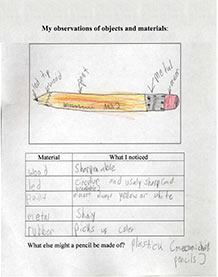How do materials help us in our classroom?
1. Discuss the challenge
Note: In this example the mystery object is a pencil, but it could be a felt tip marker or some other simple classroom object made of several materials.
To spark curiosity, introduce a mystery object hidden in a small bag. Explain that the hidden object is made of at least 5 materials, and have children guess what it is. Give clues if you need to:
- It is something you use often.
- It is probably within your reach.
- It would be hard to do your schoolwork without it.
After some guessing, reveal the pencil and describe the challenge. This object is very familiar to you. But imagine there is a third–grade class in a place far away where the students have never seen a pencil. This place is so high–tech, the students do all their schoolwork on computers — reading, writing, arithmetic, drawing — everything! You have a pen pal in that class, and she wants you to describe the pencil you use to write your letters. How are you going to do it?
Let the class brainstorm different ways to convey information about any mystery object. Talk about the advantages and disadvantages of a written description, a photograph, a video, and a drawing. Focus attention on the best way to show the pencil’s materials, and the properties that make those materials useful.

Introduce the term “observational drawing.” Explain that an observational drawing is a very careful drawing that scientists make to record important information so they can remember it and share it with others. Maybe they’ve discovered an unusual plant, or maybe they want to describe what they observed during an experiment — or maybe they want to describe a pencil to a fellow scientist in some faraway place.
Then explain that as they study objects and materials, the students will make both written notes and scientific drawings in their science notebooks — just like scientists and engineers.
- How do you think a scientist would go about making a scientific drawing?
- What would be the first thing to do?
- How can you be sure the drawing will give detailed, accurate information?
When you have consensus that the key to a good drawing is good observation, involve the students in identifying criteria for judging quality work. Write their ideas on the board.
Take a few minutes to model observational drawing for the class. Use a simple everyday object — maybe a lunchbox or a shoe. Speak your observations out loud and explain what you’re trying to do to ensure that your drawing represents the object well. You don’t need to complete the drawing, just illustrate what it means to pay attention to line, shape, and so on. Be sure to remark on parts and materials and to annotate your sketch.
Finally, let students know there is a great question to ask when you they are observing an object or making a scientific drawing of it. That question is “Why?”
- Why does this lunchbox have padded sides?
- Why is the bottom of this shoe kind of sticky?



